My dad and his lovely wife Sheryl were just recently married in the Okanagan (about 2 weeks ago). They were so generous as to fly Rob and I to B.C. from Saskatoon so we could be at the wedding. We stayed at this great little 9-hole golf resort called St. Andrews by the Lake in the Okanagan Falls. It was a gorgeous little spot! I golfed for the first time (poorly), during a night-golf tournament. I decided by about the second hole that instead of getting frustrated at my terrible game, I would drink beer along the way to make it a little bit more fun. So that is what I did.
The night golfing was only one night however, so we had some time to fill from Friday afternoon to Monday afternoon. The wedding was on Saturday, September 30th, right by the lake, and one of the greens. There was a very small group of us (only 9 people) but we had a LOT of fun! How? Well, the Thomas family knows how to party!
On Sunday, we drove in to Oliver which is only about 30 minutes from the Okanagan Falls, to do a little wine tour. Our first stop was
Hawthorne Mountain Vineyards, the view from the winery was breathtaking. The giftshop/tasting room was very inviting and well laid out, the pours were quite generous (considering the tastings were free). We tasted quite a few of their wines but I was particularily excited about tasting their Meritage which is called "Ping." The wine had been built up for me when I worked at a VQA store in B.C. last summer so I had very high expectations. I think this wine has the potential to be very good in a few years but drunk young, the tannins were too harsh in my opinion (tannins are derived from the skins and stems of the grapes and cause that feeling of your lips sticking to your teeth). We also tried their Ehrenfelser Icewine which I thought was very good (this tasting was not free, icewines usually aren't), it had strong flavours of honey and apricots.
The next winery we went to was
Wild Goose. Rob was not impressed that we all (Rob, Sheryl's daughter Meagan, her friend Tony, and I) got ID'd even though he has facial hair and wears a wedding band. I wasn't as upset about it because I'm used to getting ID'd, no biggie. We tasted some of their wines, one of which was their Bryant, which is a port style wine but they are not allowed to call it Port because it is not made in Portugal. This was very good, it was not too sweet and was quite plummy. Another one we tasted at Wild Goose was their Botrytis
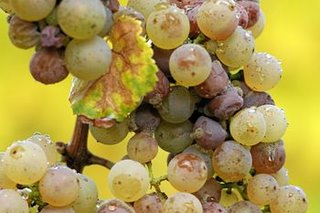
affected Riesling which I really enjoyed. Botrytis is another name for Noble Rot, which is a grey fungus that affects wine grapes. If the grapes are affected under moist conditions, the fungus can ruin entire crops of wine grapes. If the grapes are exposed when they are ripe, then are exposed to drier conditions, the grapes become raisin like and are literally hand picked one by one and can produce a fine, sweet, concentrated wine.
The Wild Goose Botrytis affected Riesling had strong flavours of honey and pineapple, I wasn't very fond of the aftertaste. It reminded me of the feeling you get in your mouth after eating a piece of pineapple. No one else thought it did this, so maybe I'm just crazy;)
The next winery we went to was directly across the street from Wild Goose, called
Tangled Vines. This winery had something I would really like to support. They give proceeds of their rosé wine, called Tickled Pink, to Breast Cancer Research. Unfortunately I wasn't very fond of this wine. I really like the idea behind the donation, but it just wasn't very good wine in my opinion. This winery only produces white wines. We tasted their Pinot Blanc, Gewurztraminer, Riesling, and the Tickled Pink
rosé. The gewurztraminer didn't have any spice or lychee taste at all. The Riesling was very bland with no tropical fruit flavours, so I was a little dissapointed. On the other hand, the tasting shop was the most inviting of all of the wineries we went to over the weekend. There were three very personable young guys pouring the wines and some cool art on the walls. It has a very young and modern feel to it; too bad the wines are lacking :(
We went to one right beside Wild Goose called
Stag's Hollow where we started off tasting a couple of Chardonnay's. One stored in oak casks, and one stored in stainless steel casks. I tasted both and found the oaked chardonnay to have HUGE aromas of oak and vanilla, which I love, but then was very dissapointed at the flavours when I tasted it. It was very weak on the palate. Next we tasted their Pinot Noir which I found to be quite weak as well, it didn't have any earth or cherry flavours and was very bland. Their Merlot however was quite good, it was very chocolatey on the finish. I found their Meritage to be too tannic and too high in alcohol content.
Next we went to the
Jackson Triggs winery which, as I expected, was very cold and large. Jackson Triggs is one of the largest wineries in Canada so it is hard for them to keep it warm and cozy. Their tasting shop was very large, with all their wine displayed nicely along the walls of the dim-lit tasting room. I've tasted a few of their wines before but tasted them again since we were there. We tasted their Grand Reserve Sauvignon Blanc, which was citrusy and grassy as a Sauv Blanc should be, next was their Viognier (pronouced: Vee-ohn-yay) which I really like, its very full bodied like a chardonnay but not oaky, or buttery like a chard. It has notes of tropical fruit and is very strong. Viognier is one of my favourite white wines. We then tasted their Shiraz, which is very spicy with berry flavours. Their Grand Reserve Meritage which I wasn't super impressed with, is too tannic, and their Cabernet Sauvignon is not that fabulous either.
The next part of the tour was kind of interesting. We were in the Nk'Mip(pronounced: Ink-ah-meep) area, so we thought "We must be close to the Nk'Mip

winery!" we went in search of it and saw signs that said "Nk'Mip vineyards", so we followed the signs that led us to something that looked like it was fresh out of an Alfred Hitchcock film in the middle of the sticks with a bunch of semi-trucks parked and an old abandoned looking barn. We cruise up in my uncles BMW SUV and roll down the window to ask some sketchy looking guys wearing mack jackets if this was where the winery was. They looked at us like we all had three heads each and then told us that the VINEYARD was there, but the WINERY was in Osoyoos. We weren't even close to Osoyoos, so we rolled up the windows and drove back down the creepy windy road to civilization.
That was the end of our wine tasting for that day. Don't worry though, we continued it a couple of days later on our way to the Kelowna airport from the Okanagan Falls. We first stopped at
Deep Creek & Hainle Vineyards in Peachland. A cool thing about this winery is that it plays a little part in wine history. Hainle is the birthplace of Icewines in North America which, as far as I know was an accidental discovery. I really like a lot of their wines and especially like the fact that their wines are organic, from the vineyards to the bottle, they do not spray their vines with pesticides or add a ton of sulphites. Organic wines are good for people that are prone to getting headaches from drinking wine. Sulphites make this worse, so although organic wines still have some sulphites, not nearly the quantities as other wines that are not organic.
I have a couple of favourites from this winery and have purchased them in Vancouver at a couple of different VQA wine stores. One of my favourites is their Gewurztraminer, which is quite spicy with strong flavours of lychee (my fav'). Another is their Deep Creek Zweigelt (pronounced: tzvi-gelt) which is originally a grape varietal from Austria and Hungary (the winemaker is Austrian) but has been brought to B.C. Deep Creek makes a Zweigelt that has soft flavours of plum, chocolate, and pepper. It's very good and I recommend you try it. We tasted a whole bunch of other wines here but I won't list them all, just my favourites, they're all quite good in my opinion.
Next stop was
Mt. Boucherie. We tasted 4 wines

here, their Semillon (pronounced: Sem-ee-yon), Ehrenfelser (my fav'), Blaufrankisch (pronounced: Blo-fronk-ish), and their Merlot. The Ehrenfelser was slightly sweet, with flavours of peach, and citrus. Rob really liked the Blaufrankisch, which tasted to me like tobacco and dirt. My sweetie likes his earthy, hearty wines! Those wines are NOT for me but hey, to each his own!
Ok, only two more wineries to tell you about!
We stopped in at the
Quails' Gate Estate Winery to taste a few of their wines. We tasted their Chasselas-Pinot Blanc(pronounced: Chass-a-la) which is a great summer wine, its not very complex, but is very refreshing nonetheless with flavours of melon fruits and citrus. Their Old Vines Foch was Rob's favourite, from this winery. It is very fullbodied with a strong earthy(a nice way of saying "It tastes like dirt") and coffee taste. I was not a fan of this wine, but my hubby and I always manage to come to a compromise when it comes to buying wine.
The next stop was the MOTHER of all wineries in Canada,
Mission Hill. The winery is HUGE and very elaborate. The proprietor, Anthony Von Mandl is a very passionate man with a $3 million bell tower, and pelican statues, and big empty rooms with beautiful tapestries on the walls. The whole place is beautiful, with a gorgeous view and amazing architecture. I guess that's what

happens when a really rich and passionate person designs a winery and vineyard. We didn't taste any of the wines here because Rob and I have both tasted pretty much everything in their portfolio. When we lived in White Rock, B.C. I worked for a fine wine boutique called Mark Anthony's, Purveyor of Fine Wines Worldwide. Mark Anthony's is owned by Mission Hill, so even though they had a HUGE selection of import wines from all over the world, the only Canadian wines sold in the store were Mission Hill products. We did a LOT of in-store tastings so I got to taste all of them(I know...it was a REALLY tough job, but somebody had to do it).
If you ever get the chance to taste Mission Hill's Oculus, I strongly recommend you do. It is one of my favourite wines, which kind of sucks because it is quite expensive and hard to get.
So that was the end of our wonderful long weekend in the Okanagan with my dad and my new Step-mom(I'm sure she LOVES that new title! lol) We had a great time and are really looking forward to going back to BC for the Christmas holidays. We're hoping that our dear friends Dan and Kathy will organize another wine tasting party at Dan's house while we're home. ;)
Cheers!
Andrea
 Sure you can get a good bottle of it now and again, but it seems that every winery produces it the same way leaving it tasting a little bit less than unique. I find myself just skipping right past the Australian section at the liquor store everytime I am in there now.
Sure you can get a good bottle of it now and again, but it seems that every winery produces it the same way leaving it tasting a little bit less than unique. I find myself just skipping right past the Australian section at the liquor store everytime I am in there now.


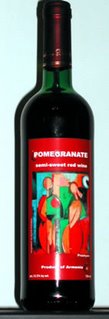










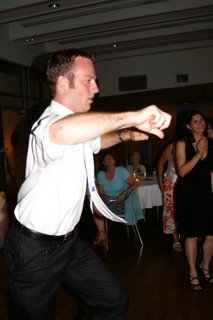
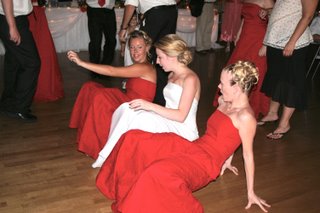
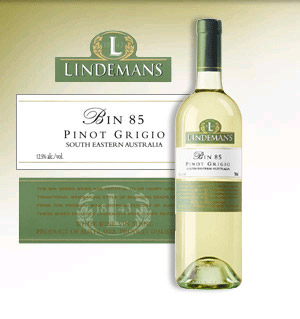




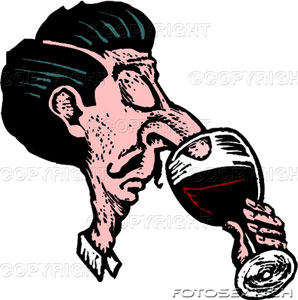
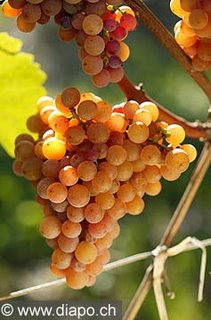

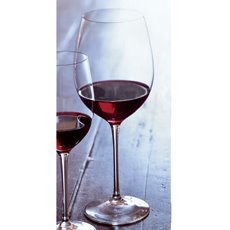













 For my first post I'll explain how my amazing wine blog came to be. Rob and I went to a little restaurant in Saskatoon this evening called "The Living Room" where we had some dinner. I ordered the Thai Chicken noodle salad, Rob had the baked brie and garlic plate and we ordered a bottle of wine (Woodbridge Cabernet Sauvignon, which I will review later). We got on the topic of what living a life of content meant to both of us. We were both pretty much on par with our vision of 'the good life' which was good since we're getting married this summer ;).
For my first post I'll explain how my amazing wine blog came to be. Rob and I went to a little restaurant in Saskatoon this evening called "The Living Room" where we had some dinner. I ordered the Thai Chicken noodle salad, Rob had the baked brie and garlic plate and we ordered a bottle of wine (Woodbridge Cabernet Sauvignon, which I will review later). We got on the topic of what living a life of content meant to both of us. We were both pretty much on par with our vision of 'the good life' which was good since we're getting married this summer ;).

